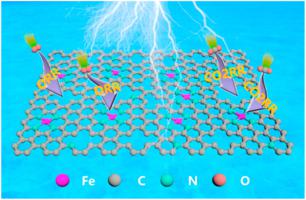Carbon ( IF 10.9 ) Pub Date : 2021-06-01 , DOI: 10.1016/j.carbon.2021.05.038 Huijuan Yang , Xingpu Wang , ShengBao Wang , Pengyang Zhang , Chi Xiao , Hirbod Maleki Kheimeh Sari , Jihu Liu , Jingchun Jia , Bin Cao , Jian Qin , Wei Xiao , Zhiyou Zhou , Xifei Li

|
Metal-N4 single-atom catalysts have emerged as the frontier of catalysis. However, the low metal loading and abundance of single atoms embedded in carbon skeleton hinder their practical application. Herein, we report an effective “trapping and exposing” strategy for constructing single-atom Fe–N4 catalysts with high density of single-atom active sites. The strategy involves the strong binding of metal ions to sucrose (trapping) to prevent the migration and agglomeration of Fe3+, followed by the introduction of a mesoporous structure using an SBA-15 template to achieve sufficient exposure of the Fe–N4 sites (exposing). The as-prepared catalyst comprises Fe–N4 moieties (10.8 wt%) with a hierarchical structure. Density functional theory calculations reveal that the chelating reaction between sucrose and Fe3+ ions has a low free energy, resulting in the formation of highly dispersed Fe–N4 single atoms. The single-atom catalyst displays a high peak power density of 0.784 W cm−2 in a H2–O2 proton exchange membrane fuel cell and achieves an impressive CO current density of 109 A g−1 at negligible overpotentials in a flow cell. This work provides an efficient strategy for designing high-performance single-atom catalysts for practical electrocatalysis applications.
中文翻译:

用于高效 O 2和 CO 2电还原的双增强单原子 Fe-N 4位点
金属-N 4单原子催化剂已成为催化领域的前沿。然而,低金属负载量和嵌入碳骨架的单原子丰度阻碍了它们的实际应用。在此,我们报告了一种有效的“捕获和暴露”策略,用于构建具有高密度单原子活性位点的单原子 Fe-N 4催化剂。该策略涉及金属离子与蔗糖的强结合(捕获)以防止 Fe 3+的迁移和团聚,然后使用 SBA-15 模板引入介孔结构以实现 Fe-N 4位点的充分暴露(暴露)。所制备的催化剂包含 Fe-N 4部分 (10.8 wt%) 具有分层结构。密度泛函理论计算表明蔗糖和Fe 3+离子之间的螯合反应具有低自由能,导致形成高度分散的Fe-N 4单原子。单原子催化剂在 H 2 -O 2质子交换膜燃料电池中显示出 0.784 W cm -2 的高峰值功率密度,并在流动电池中以可忽略的过电位实现令人印象深刻的 109 A g -1 的CO 电流密度。这项工作为设计用于实际电催化应用的高性能单原子催化剂提供了一种有效的策略。



























 京公网安备 11010802027423号
京公网安备 11010802027423号